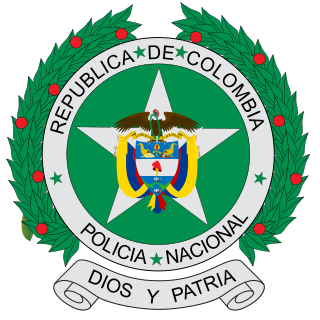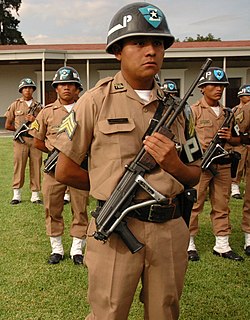
Military police (MP) are law enforcement agencies connected with, or part of, the military of a state.
The Civil Guard is the oldest law enforcement agency covering the whole of Spain. It is organised as a military force charged with police duties under the authority of both the Ministry of the Interior and the Ministry of Defence. The corps is colloquially known as the benemérita (reputable). In annual surveys, it generally ranks as the national institution most valued by Spaniards, closely followed by other law enforcement agencies and the military. It has both a regular national role and undertakes specific foreign peace-keeping missions. As a national police force, the Guardia Civil is comparable today to the French National Gendarmerie, the Italian Carabinieri, the Portuguese National Republican Guard and the Dutch Royal Marechaussee as it is part of the European Gendarmerie Force.

State police or provincial police are a type of sub-national territorial police force found in nations organized as federations, typically in North America, South Asia, and Oceania. These forces typically have jurisdiction over the relevant sub-national jurisdiction, and may cooperate in law enforcement activities with municipal or national police where either exist.
In Brazil, the Federal Constitution establishes five law enforcement institutions: the Federal Police, the Federal Highway Police, the Federal Railway Police, the State Military Police and Fire Brigade, and the State Civil Police. Of these, the first three are affiliated to federal authorities and the latter two subordinated to state governments. All police institutions are part of the Executive branch of either federal or state government. Apart from these five institutions there is another one which is affiliated to municipal authorities: the Municipal Guards. The Municipal Guards de jure is not considered a public security force, but federal law 13,022 gave them de facto police attributions.

The Guardia de Asalto was the heavy reserve force of the blue-uniformed urban police force of Spain during the Spanish Second Republic. The Assault Guards were special police units created by the Spanish Republic in 1931 to deal with urban violence.

The National Police of Colombia is the national police force of Colombia. Although the National Police is not part of the Military Forces of Colombia, it constitutes along with them the "Public Force" and is also controlled by the Ministry of Defense. Unlike many nations which use a tiered system of law enforcement, the National Police is the only civilian police force in Colombia. The force's official functions are to protect the Colombian nation, enforce the law by constitutional mandate, maintain and guarantee the necessary conditions for public freedoms and rights and to ensure peaceful cohabitation among the population.

Provosts are military police whose duties are policing solely within the Armed Forces, as opposed to gendarmerie duties in the civilian population. However, many countries use their gendarmerie for provost duties.
Law enforcement in Spain is carried out by numerous organizations, not all of which operate in the same areas.
The Policía Nacional Civil is the national police of El Salvador.
Guatemalan law enforcement, some of which is performed by its military, has a poor record with regard to human rights violations. President Otto Pérez Molina, elected in 2012, is a career military official, and has stepped up the use of military reinforcement in the country's law enforcement. During the country's civil war from 1960 to 1996, 200,000 people were killed and 45,000 forcibly disappeared.
Law enforcement in Albania is the responsibility of several agencies. The responsibility for most tasks lies with the Albanian State Police, a national police agency, which is under the authority of Ministry of Internal Affairs. Examples of other agencies with limited policing powers are the Municipal Police, which has administrative functions and operates in the local level. They are controlled by mayors.

In Spanish towns and cities, the Policia Municipal, also known as the Policia Local or Guardia Urbana, is a police force organized at the municipal level.
In many countries, particularly those with a federal system of government, there may be several law enforcement agencies, police or police-like organizations, each serving different levels of government and enforcing different subsets of the applicable law.

The Peruvian National Police is the national police force of Peru. Its jurisdiction covers the nation's land, sea, and air territories. Formed from the merge of the Investigative Police, the Civil Guard, and the Republican Guard in 1988, it is one of the largest police forces in Latin America. Its mission is to preserve domestic order, public order and national security, in order to enforce the law and protect the people of Peru. The PNP is controlled by the Peruvian Interior Ministry. The PNP has a number of divisions, tasked with enforcing specific aspects of the law; among the more well known are DINOES, DINANDRO, DININCRI, and DIRCOTE (Anti-Terrorism).

The Guatemalan genocide, Maya(n) genocide, or Silent Holocaust refers to the massacre of Maya civilians during the Guatemalan military government's counterinsurgency operations. Massacres, forced disappearances, torture and summary executions of guerrillas and especially civilian collaborators at the hands of US-backed security forces had been widespread since 1965 and was a longstanding policy of the military regime, which US officials were aware of. A report from 1984 discussed "the murder of thousands by a military government that maintains its authority by terror." Human Rights Watch has described "extraordinarily cruel" actions by the armed forces, mostly against unarmed civilians.
The Secret Anti-Communist Army was a front organization that operated in Guatemala and El Salvador during the Guatemalan Civil War. Like other earlier organizations, such as the MANO and the CADEG, the ESA existed as a front for a covert program of selective assassination by the Guatemalan security services. The first documentation of it came from the New York Times on 4 August 1977. The ESA made its existence more widely known during the upheaval caused by the September 1978 bus fare strikes in Guatemala City. On 18 October 1978, the ESA authored the first of a series of public bulletins containing "death lists" of persons which the organization considered to be "communists". It claimed to be independent, but was coordinated and staffed by members of the military and security services and was allegedly run by Colonel German Chupina Barahona, Director General of the National Police (PN) from 1978 to 1982. Often, the lists of targets were provided by the Minister of the Interior, Donaldo Alvarez Ruiz.









